Research
3D Printed Ti3C2Tx MXene/Cellulose Nanofiber Architectures for Solid-State Supercapacitors: Ink Rheology, 3D Printability, and Electrochemical Performance
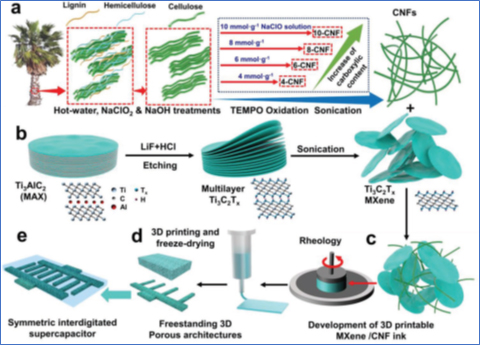
Direct ink writing technology is capable of using 2D MXene to construct 3D architectures for electrochemical energy storage (EES) devices that are normally difficult to achieve using conventional techniques. However, to meet specific rheological requirements for 3D printing, a large amount of MXene is needed in the ink, resulting in a severe self-restacking structure after drying. Herein, a series of cellulose nanofibers (CNFs) with different morphologies and surface chemistries are applied to enhance the rheology of the MXenebased inks with exceptional 3D printability. Various 3D architectures with superior shape fidelity and geometric accuracy are successfully printed using the optimized hybrid ink at a low solid content, generating self-standing, hierarchically porous structures after being freeze-dried, which improves surface area accessibility, ion transport efficiency, and ultimately, capacitive performance. A solid-state interdigitated symmetrical supercapacitor is further 3D printed, which delivers an areal capacitance of 2.02 F cm-2 and an energy density of 101 μWh cm at a power density of 0.299 mW cm-2, and maintains a capacitance retention rate of 85% after 5000 cycles. This work demonstrates the integration of 1D CNFs and 2D MXene in 3D printing technology to prepare customized, multiscale, and multidimensional architectures for the next generation of EES devices. Adv. Funct. Mater. 2021, 2109593.
Rheological Properties of Lignocellulosic Nanomaterial Aqueous Suspensions as Influenced by Water-Soluble Biopolymer Additives
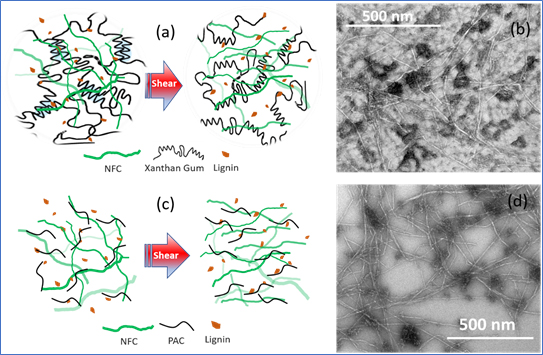
Rheological properties including gel strength, steady-state viscosity, and oscillatory rheology of four types of cellulose nanomaterials (CNMs) under the influence of two different biopolymers were studied. The processed CNMs had distinct fiber morphology (individual fibril vs bundles with/ without lignin particles), composition (lignin content varying from 52.88% to 6.86%), and surface chemical properties (zeta potential values from −28.62 mV to −13.4 mV). The presence of lignin in lignin-containing nanofibrillated cellulose (LNFC) decreased a suspension’s gel strength, viscosity, and dynamic modulus. The chosen bleached NFC contained large fibril bundles, and the processed material with more individualized fibril and enhanced fluid rheology was demonstrated after regrinding the original NFC. Biopolymer xanthan gum (XG) showed a much larger effect in modifying gel strength, viscosity, and dynamic moduli compared with polyanionic cellulose (PAC). Among the three chosen rheological models, the Nasiri−Ashrafizadeh model fitted the measured shear stress and shear rate data the best for each fluid system with correlation coefficients larger than 0.99. The use of biopolymers (e.g., XG and PAC) helped reduce negative effect of lignin on gel strength and other rheological properties for LNFC. The much improved rheological performance for biopolymer-modified LNFC suspensions open new opportunities for CNMs to be used as more environmentally friendly fluids for the energy industry. ACS Sustainable Chem. Eng. ACS Sustainable Chem. Eng. 2021, 9, 50, 17049–17060.
A cellulose nanofiber–polyacrylamide hydrogel based on a co-electrolyte system for solid-state zinc ion batteries to operate at extremely cold temperatures
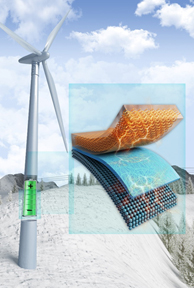 A wood-based CNF–polyacrylamide hydrogel was developed based on the Me56 hybrid electrolyte.
The Me56 hybrid electrolyte shows a freezing point lower than -100 oC due to thestrong hydrogen bonds between methanol molecular clusters with H2O molecules. The reversibility of the Zn anode is also boosted in this antisolvent
since the Zn2+ solvation is weakened and corrosion reaction is suppressed. Based on
the Me56 hybrid electrolyte, the developed CNF–PAM hydrogel electrolyte maintains
its excellent mechanical properties at low temperatures, enabling the solid-state
zinc ion batteries (ssBs) to be workable under repeated bending and twisting under
very cold conditions. At the extremely low temperature of -60 oC, excellent electrochemical performance is also maintained. This developed CNF-PAM
hydrogel with the hybrid electrolyte shows great potential to be applied in batteries
for wearable devices in cold environments. The technology can also be potentially
applied to build ssBs for extremely low temperature energy storage in remote areas.
J. Mater. Chem. A, 2021, 9, 25651–25662.
A wood-based CNF–polyacrylamide hydrogel was developed based on the Me56 hybrid electrolyte.
The Me56 hybrid electrolyte shows a freezing point lower than -100 oC due to thestrong hydrogen bonds between methanol molecular clusters with H2O molecules. The reversibility of the Zn anode is also boosted in this antisolvent
since the Zn2+ solvation is weakened and corrosion reaction is suppressed. Based on
the Me56 hybrid electrolyte, the developed CNF–PAM hydrogel electrolyte maintains
its excellent mechanical properties at low temperatures, enabling the solid-state
zinc ion batteries (ssBs) to be workable under repeated bending and twisting under
very cold conditions. At the extremely low temperature of -60 oC, excellent electrochemical performance is also maintained. This developed CNF-PAM
hydrogel with the hybrid electrolyte shows great potential to be applied in batteries
for wearable devices in cold environments. The technology can also be potentially
applied to build ssBs for extremely low temperature energy storage in remote areas.
J. Mater. Chem. A, 2021, 9, 25651–25662.
Comparative performance of bio-based coatings formulated with cellulose, chitin, and chitosan nanomaterials suitable for fruit preservation.
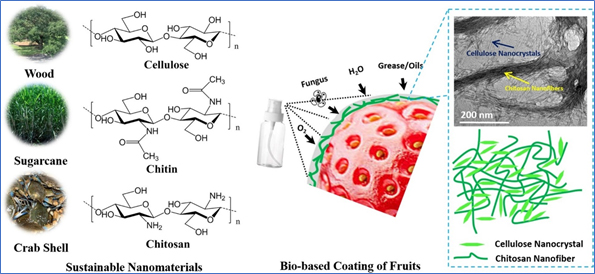
Aqueous suspensions of the manufactured sustainable nanomaterials (SNM) from wood, sugarcane and crab shell exhibited a shear thinning behavior, which enabled them to be sprayed on fruit surface easily. The actual viscosities of the suspensions were governed by the material aspect ratio and concentrations. The fruit surface morphology (e.g., trichomes, seeds), surface wax components and cutin monomers (e.g., long-chain fatty alcohols, C16 monomers) had a great influence on the fruit surface free energy. The OWRK model is recommended to be used in the calculation of the total surface free energy (SFE), polar, and dispersive components. The enclosed areas of the contours in the wetting envelopes had a positive relationship with the total SFE of the fruit surfaces. The shape of the wetting envelopes was related to the values of polar and dispersive components. All the SNM coatings exhibited good antifungal activity and helped maintain fruit freshness. The antifungal activity was influenced by the functional groups and particle size of these nanomaterials. Cellulose sources (wood or sugarcane) did not have significant effect on the antifungal activity performance. The wood cellulose nanocrystal/chitosan nanofibers (WCNC/CSNF) blend exhibited the best performance in antifungal activity and color change delay. The study provides an alternative way for developing a fruit coating system to enhance their shelf life. Carbohydrate Polymers 259, 1, 2021, 117764.
Salt Contamination of Bentonite Water-based Drilling Fluids with Blended Dual-Functionalized Cellulose Nanocrystals
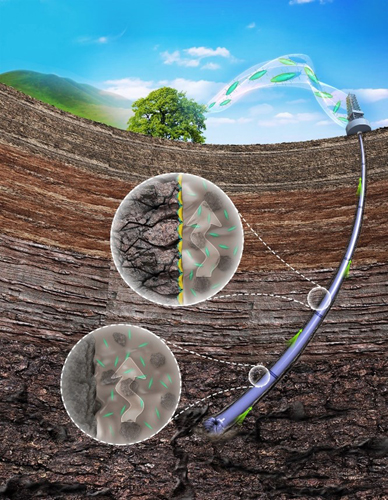 The depletion of onshore oil reserves along with rapid increase in global energy demand
have driven oil industry to explore and produce oil from deepwater field. However,
due to the high salinity in the subsea formation, salt contamination is becoming one
of the most critical challenges to bentonite-water-based drilling fluids (BT-WDFs),
causing undesirable changes in the density, rheological and filtration properties.
Herein, we reveal the mechanisms of salt contamination in BT-WDFs, and demonstrate
the effectiveness of biomass-derived cellulose nanocrystals (CNCs) as anti-salt agents
in BT-WDFs through rational dual surface functionalization for the first time. ACS Sustainable Chem. Eng. 2020, 8, 11569−11578.
The depletion of onshore oil reserves along with rapid increase in global energy demand
have driven oil industry to explore and produce oil from deepwater field. However,
due to the high salinity in the subsea formation, salt contamination is becoming one
of the most critical challenges to bentonite-water-based drilling fluids (BT-WDFs),
causing undesirable changes in the density, rheological and filtration properties.
Herein, we reveal the mechanisms of salt contamination in BT-WDFs, and demonstrate
the effectiveness of biomass-derived cellulose nanocrystals (CNCs) as anti-salt agents
in BT-WDFs through rational dual surface functionalization for the first time. ACS Sustainable Chem. Eng. 2020, 8, 11569−11578.
Rheological Aspects of Cellulose Nanomaterials
 Cellulose nanomaterials (CNMs), mainly including nanofibrillated cellulose (NFC) and
cellulose nanocrystals (CNCs), have attained an enormous interest due to their sustainability,
biodegradability, biocompatibility, nanoscale dimensions, large surface area, facile
modification of surface chemistry, as well as unique optical, mechanical and rheological
performance. One of the most fascinating properties of CNMs is their aqueous suspension
rheology, i.e., CNMs helping create viscous suspensions in an aqueous solution with
the formation of percolation networks and chemical interactions (e.g., Van der Waal
forces, hydrogen bonding, electrostatic attraction/repulsion and hydrophobic attraction).
Under continuous shearing, CNMs in an aqueous solution can align along the flow direction,
producing profound shear-thinning behavior. At rest, CNM suspensions regain their
initial structure immediately, allowing rapid recovery of rheological properties.
These unique flow features enable CNMs to serve as rheological modifiers in a wide
range of fluid-based applications. This review systematically describes the dependence
of rheology of CNMs on test protocols, CNM inherent properties, suspension environments,
and post processing. A critical overview of recent progress on fluid applications
of CNMs as rheology modifiers in some emerging industrial sectors is presented as
well. Future perspectives in the field are outlined to guide further research and
development in using CNMs as the next generation rheological modifiers. Advanced Materials. DOI: 10.1002/adma.202006052.
Cellulose nanomaterials (CNMs), mainly including nanofibrillated cellulose (NFC) and
cellulose nanocrystals (CNCs), have attained an enormous interest due to their sustainability,
biodegradability, biocompatibility, nanoscale dimensions, large surface area, facile
modification of surface chemistry, as well as unique optical, mechanical and rheological
performance. One of the most fascinating properties of CNMs is their aqueous suspension
rheology, i.e., CNMs helping create viscous suspensions in an aqueous solution with
the formation of percolation networks and chemical interactions (e.g., Van der Waal
forces, hydrogen bonding, electrostatic attraction/repulsion and hydrophobic attraction).
Under continuous shearing, CNMs in an aqueous solution can align along the flow direction,
producing profound shear-thinning behavior. At rest, CNM suspensions regain their
initial structure immediately, allowing rapid recovery of rheological properties.
These unique flow features enable CNMs to serve as rheological modifiers in a wide
range of fluid-based applications. This review systematically describes the dependence
of rheology of CNMs on test protocols, CNM inherent properties, suspension environments,
and post processing. A critical overview of recent progress on fluid applications
of CNMs as rheology modifiers in some emerging industrial sectors is presented as
well. Future perspectives in the field are outlined to guide further research and
development in using CNMs as the next generation rheological modifiers. Advanced Materials. DOI: 10.1002/adma.202006052.
A Chemically Self-Charging Flexible Solid-state Zinc Ion Battery based on VO2 Cathode and Polyacrylamide-Chitin Nanofiber Hydrogel Electrolyte
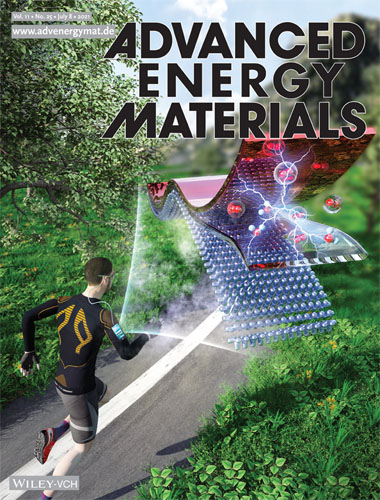 Self-charging power systems applied in portable energy storage devices has received
an extensive attention. However, conventional self-charging systems are generally
complicated and highly relied on availability of energy sources. Herein, we develop
a chemically self-charging, flexible solid-state zinc ion battery (ssZIB) based on
vanadium dioxide (VO2) cathode and polyacrylamide-chitin nanofiber (PAM-CNF) hydrogel electrolyte. At a
current density of 0.2 A·g-1, the ssZIBs deliver the specific capacity of 343.9 mAh·g-1. And with the power densities of 139.0 W·kg-1, it can still deliver the high energy density of 231.9 Wh·kg-1. The superior electrochemical performance of the ssZIBs is attributed to the robust
tunnel structure of VO2 cathode and the network of PAM-CNF electrolyte, which provides
efficient pathways for ion diffusion. Impressively, the designed ssZIBs can be chemically
self-charged by the redox reaction between the cathode and oxygen at ambient condition.
After oxidation for 6 h in air, the ssZIBs manifest a high discharging capacity of
263.9 mAh·g-1 at 0.2 A·g-1, showing excellent self-rechargeability. More importantly, such ssZIBs are able to
operate well at chemical or/and galvanostatic charging hybrid modes, demonstrating
superior reusability. This work brings a new prospect of designing flexible chemically
self-charging ssZIBs for the portable self-powered systems. Advanced Energy Materials. doi.org/10.1002/aenm.202003902
Self-charging power systems applied in portable energy storage devices has received
an extensive attention. However, conventional self-charging systems are generally
complicated and highly relied on availability of energy sources. Herein, we develop
a chemically self-charging, flexible solid-state zinc ion battery (ssZIB) based on
vanadium dioxide (VO2) cathode and polyacrylamide-chitin nanofiber (PAM-CNF) hydrogel electrolyte. At a
current density of 0.2 A·g-1, the ssZIBs deliver the specific capacity of 343.9 mAh·g-1. And with the power densities of 139.0 W·kg-1, it can still deliver the high energy density of 231.9 Wh·kg-1. The superior electrochemical performance of the ssZIBs is attributed to the robust
tunnel structure of VO2 cathode and the network of PAM-CNF electrolyte, which provides
efficient pathways for ion diffusion. Impressively, the designed ssZIBs can be chemically
self-charged by the redox reaction between the cathode and oxygen at ambient condition.
After oxidation for 6 h in air, the ssZIBs manifest a high discharging capacity of
263.9 mAh·g-1 at 0.2 A·g-1, showing excellent self-rechargeability. More importantly, such ssZIBs are able to
operate well at chemical or/and galvanostatic charging hybrid modes, demonstrating
superior reusability. This work brings a new prospect of designing flexible chemically
self-charging ssZIBs for the portable self-powered systems. Advanced Energy Materials. doi.org/10.1002/aenm.202003902
Novel Alginate-Cellulose Nanofibers–Poly(vinyl alcohol) Hydrogels for Carrying and Delivering Nitrogen, Phosphorus and Potassium Chemicals
 A novel nanocomposite hydrogels was successfully prepared by crosslinking of sodium
alginate (SA), poly(vinyl alcohol) (PVA) and cellulose nanofibers (CNFs) in the presence
of a fertilizer formulation containing nitrogen (N), phosphorus (P) and potassium
(K). The hydrogel had a macroporous interpenetrating polymer network (IPN) core and
a microporous semi-IPN shell. The crystalline nature of the NPK chemicals was retained
in the hydrogel nanocomposite network. Additionally, the SA/CNF/PVA-based hydrogels
showed a higher water-retention capacity in both deionized water and mixed soil. The
swelling behavior in various physiological pH, salt and alkali solutions exhibited
good sensitivity. The NPK release from SA/CNF/NPK and SA/CNF/PVA/NPK hydrogels was
controlled by Fickian diffusion in both water and soil based on the Korsmeyer-Peppas
release kinetics model (n < 0.5). The prepared hydrogels have the potential for applications
in drought-prone and/or fertilizer-loss regions for future agricultural and horticultural
development. International Journal of Biological Macromolecules, 172 (2021): 330-340
A novel nanocomposite hydrogels was successfully prepared by crosslinking of sodium
alginate (SA), poly(vinyl alcohol) (PVA) and cellulose nanofibers (CNFs) in the presence
of a fertilizer formulation containing nitrogen (N), phosphorus (P) and potassium
(K). The hydrogel had a macroporous interpenetrating polymer network (IPN) core and
a microporous semi-IPN shell. The crystalline nature of the NPK chemicals was retained
in the hydrogel nanocomposite network. Additionally, the SA/CNF/PVA-based hydrogels
showed a higher water-retention capacity in both deionized water and mixed soil. The
swelling behavior in various physiological pH, salt and alkali solutions exhibited
good sensitivity. The NPK release from SA/CNF/NPK and SA/CNF/PVA/NPK hydrogels was
controlled by Fickian diffusion in both water and soil based on the Korsmeyer-Peppas
release kinetics model (n < 0.5). The prepared hydrogels have the potential for applications
in drought-prone and/or fertilizer-loss regions for future agricultural and horticultural
development. International Journal of Biological Macromolecules, 172 (2021): 330-340